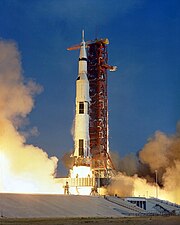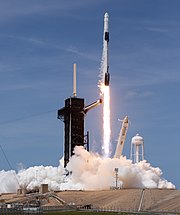| This Wikipedia page has been superseded by Portal:Rocketry and is retained primarily for historical reference. |
| Note: Article entries are now being transcluded directly on the main portal page. However, this page should be retained for historical reference. |
| № | Image | Text |
|---|---|---|
| 1 |  |
Section 'SSCD-rocketry' not found
|
| 2 |  |
Black Arrow, officially capitalised BLACK ARROW, was a British satellite expendable launch system. Black Arrow originated from studies by the Royal Aircraft Establishment for carrier rockets based on the earlier Black Knight rocket; the project was authorised by the British government in late 1964. Development of Black Arrow was largely performed by the prime contractor, the British aerospace company Saunders-Roe, and later undertaken by Westland Aircraft as the result of a merger. Both the first and second stage engines were produced by Bristol Siddeley at their factory in Ansty, Warwickshire. Assembly of the first and second stages was carried out at East Cowes on the Isle of Wight. Once manufactured, each Black Arrow vehicle was transported by ship to Australia prior to being launched from the RAAF Woomera Range Complex. Black Arrow was a three-stage rocket, fuelled by RP-1 paraffin (kerosene) and high-test peroxide, a concentrated form of hydrogen peroxide (85% hydrogen peroxide + 15% water). While the first two stages featured thrust vectoring to provide attitude control, the third stage did not have an attitude control system, and instead relied upon spin stabilization along with a reaction control system. The first stage was designed to be compatible with Blue Streak, as well as to be interchangeable with Coralie. Furthermore, several derivatives of Black Arrow were proposed to provide for increased payload capacity. A total of four launches of Black Arrow were performed between 1969 and 1971, the first two being demonstration flights to prove the launcher's capabilities. While the first and third flights were failures, the second and fourth flights were successful. Black Arrow's final flight placed the Prospero satellite into low Earth orbit, making it the first and only successful orbital launch to be conducted by the United Kingdom. British officials decided to discontinue the programme in favour of using American Scout rockets instead, the Ministry of Defence having calculated this option to be cheaper than continuing with Black Arrow. |
| 3 |  |
The Saturn V[a] is a retired American super heavy-lift launch vehicle developed by NASA under the Apollo program for human exploration of the Moon. The rocket was human-rated, had three stages, and was powered by liquid fuel. Flown from 1967 to 1973, it was used for nine crewed flights to the Moon, and to launch Skylab, the first American space station. As of 2024,[update] the Saturn V remains the only launch vehicle to have carried humans beyond low Earth orbit (LEO). The Saturn V holds the record for the largest payload capacity to low Earth orbit, 311,152 lb (141,136 kg), which included unburned propellant needed to send the Apollo command and service module and Lunar Module to the Moon. The largest production model of the Saturn family of rockets, the Saturn V was designed under the direction of Wernher von Braun at the Marshall Space Flight Center in Huntsville, Alabama; the lead contractors for construction of the rocket were Boeing, North American Aviation, Douglas Aircraft Company, and IBM. Fifteen flight-capable vehicles were built, not counting three used for ground testing. A total of thirteen missions were launched from Kennedy Space Center, nine of which carried 24 astronauts to the Moon from Apollo 8 (December 1968) to Apollo 17 (December 1972). |
| 4 |  |
Notes
edit- ^ Pronounced "Saturn five". "V" is the roman numeral for 5.